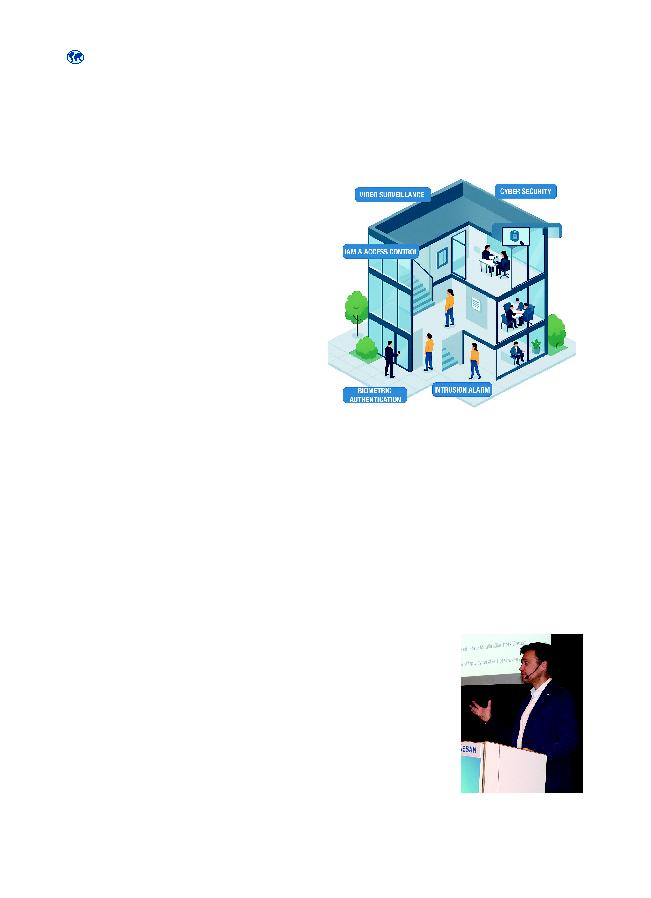
Smart
Buildings
According to a report from market
analysis firm Memoori, the global
market for the Building Internet of
Things (BIoT) is expected to grow
from USD 64.1 billion in 2024
to USD 101.0 billion in 2030,
representing a compound annual
growth rate of 7.87 per cent sig-
nificantly lower than the historical
growth rates of 1016 per cent.
A software-oriented trend
According to James McHale,
market analyst and founder of
Memoori, the category Data
Integration, Analytics & Software
represents the largest and fastest-
growing segment, with a growth
rate of 9.53 per cent.
"This shows that the mar-
ket is increasingly focusing on
software-defined value rather than
hardware," he comments.
The importance of security
As properties adopt IoT, cloud and
AI technologies to create safer and
more efficient environments, phys-
ical security systems ensure these
digital ecosystems remain robust.
They protect people, assets and
operations while also providing
data that enhances building per-
formance. Without strong access
control and video surveillance, the
promise of `smartness' risks being
undermined by vulnerabilities.
A business resource
James McHale, founder and CEO
of Memoori, stresses that security
has long been seen as a necessary
evil rather than a strategic tool
but that is changing.
"Security has largely been
viewed as something you must
have to gather evidence when
something happens, and therefore
not directly contributing to ROI.
But with IoT, security providers
now have the opportunity to be
more involved in the organisation's
operational processes.
This reflects a shift where secu-
rity in smart buildings is no longer
seen merely as a protective tool,
but as a resource for business value
creation."
Security as a
major component
Although energy optimisation
and automation often dominate
the discussion around smart
buildings, the physical security
industry actually accounts for one
of the largest shares of investment.
According to Market.us, 5060
per cent of the installed technol-
ogy in smart buildings consists of
physical security systems mainly
access control and video surveil-
lance.
Services make up an even
larger part of the ecosystem: the
Security Industry Association
estimates that the value of services
such as remote monitoring and
maintenance reached nearly USD
300 billion as early as 2022
underlining how central security is
to both operations and budgets in
smart buildings.
Gatekeeper and data source
Modern access control is far more
than keys and locks. Digital identi-
ties ranging from mobile apps
to biometric solutions enable
property owners and operators to
grant, revoke and monitor access in
real time.
· Operational efficiency: Logs
provide insights into space utilisa-
tion and occupancy.
· Security and resilience: Lost
credentials can be immediately
deactivated.
Smart buildings are no longer defined solely by en-
ergy efficiency, automation or connectivity. At their
core lies another crucial component: physical se-
curity systems. Access control, video surveillance
and related technologies are evolving from being
standalone protective measures into integrated
parts of the smart building ecosystem.
The role of physical security systems in smart buildings
· User experience: Smooth,
contactless solutions increase con-
venience, particularly in high-traffic
environments.
In smart buildings, access con-
trol is therefore not only a security
feature but also a tool for opti-
mising resource use and improving
user experience.
From surveillance
to intelligence
Video surveillance is evolving rap-
idly. According to Memoori's 2023
market report, the global video
surveillance market was worth
USD 30.4 billion in 2022 and is
expected to reach nearly USD 45
billion by 2028.
Growth is largely driven by
AI and edge analytics, which
make systems more proactive and
intelligent. Memoori predicts that
by 2028, more than half of all net-
work cameras will have built-in AI
capabilities. This enables real-time
detection of anomalies, intrusions
or safety risks. When integrated
with access control, every entry
event can also be visually verified
enhancing accountability and
reducing false alarms.
Integration with other
building systems
The real strength of physical security
in smart buildings lies in interoper-
ability. When security systems are
linked with, for example, ventila-
tion, lighting, visitor management
or alarms, they become part of a co-
ordinated and responsive ecosystem.
For instance:
· Lighting and ventilation can auto-
matically adjust based on occupancy
data from the access control system.
· In an emergency, lockdowns
or evacuation procedures can be
automatically triggered through the
Without robust access control, video surveillance and intrusion detection, a building's
`smartness' risks being undermined by vulnerabilities.
James McHale, market analyst and
founder of Memoori.
2 2 · d e t e k t o r i n t e r n a t i o n a l

